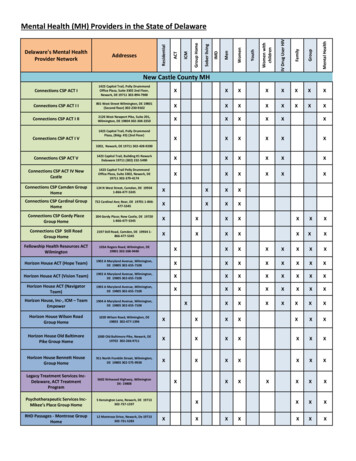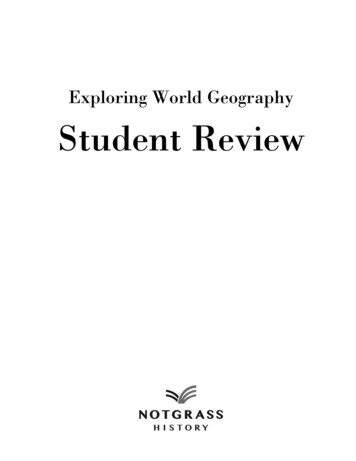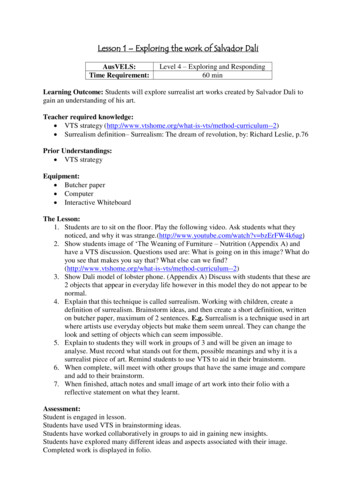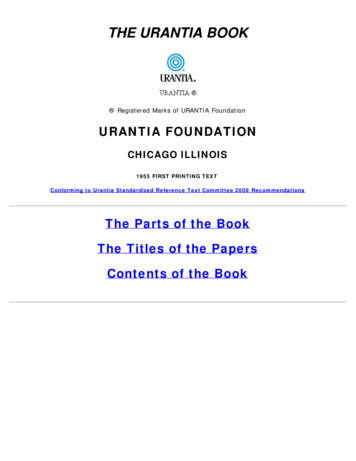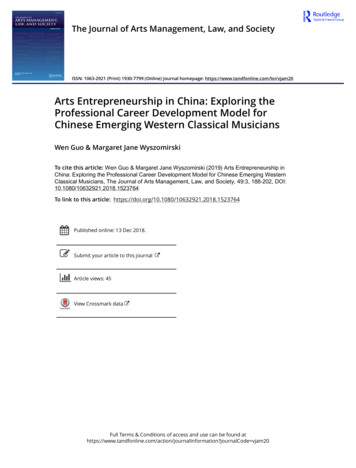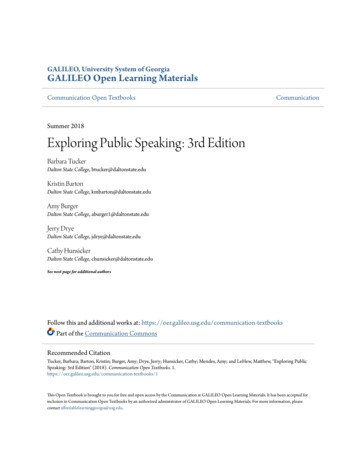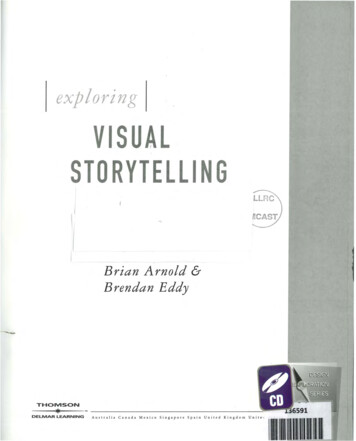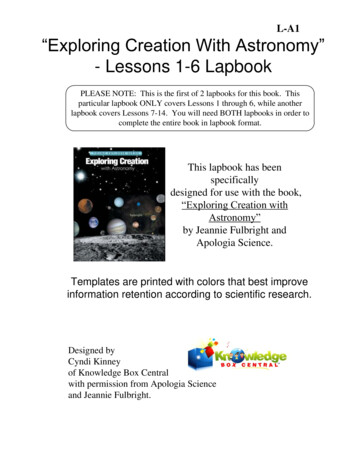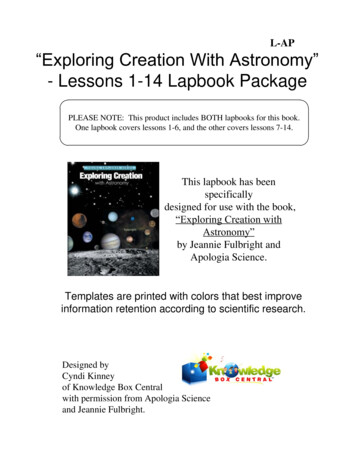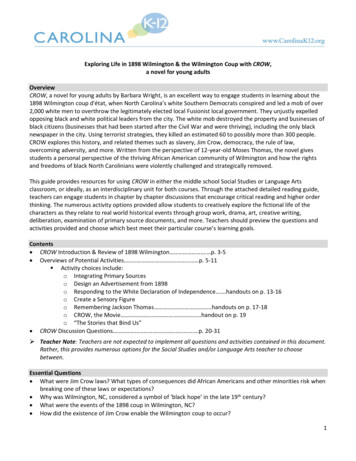
Transcription
Exploring Life in 1898 Wilmington & the Wilmington Coup with CROW,a novel for young adultsOverviewCROW, a novel for young adults by Barbara Wright, is an excellent way to engage students in learning about the1898 Wilmington coup d'état, when North Carolina’s white Southern Democrats conspired and led a mob of over2,000 white men to overthrow the legitimately elected local Fusionist local government. They unjustly expelledopposing black and white political leaders from the city. The white mob destroyed the property and businesses ofblack citizens (businesses that had been started after the Civil War and were thriving), including the only blacknewspaper in the city. Using terrorist strategies, they killed an estimated 60 to possibly more than 300 people.CROW explores this history, and related themes such as slavery, Jim Crow, democracy, the rule of law,overcoming adversity, and more. Written from the perspective of 12-year-old Moses Thomas, the novel givesstudents a personal perspective of the thriving African American community of Wilmington and how the rightsand freedoms of black North Carolinians were violently challenged and strategically removed.This guide provides resources for using CROW in either the middle school Social Studies or Language Artsclassroom, or ideally, as an interdisciplinary unit for both courses. Through the attached detailed reading guide,teachers can engage students in chapter by chapter discussions that encourage critical reading and higher orderthinking. The numerous activity options provided allow students to creatively explore the fictional life of thecharacters as they relate to real world historical events through group work, drama, art, creative writing,deliberation, examination of primary source documents, and more. Teachers should preview the questions andactivities provided and choose which best meet their particular course’s learning goals.Contents CROW Introduction & Review of 1898 Wilmington . p. 3-5 Overviews of Potential Activities p. 5-11Activity choices include:o Integrating Primary Sourceso Design an Advertisement from 1898o Responding to the White Declaration of Independence . handouts on p. 13-16o Create a Sensory Figureo Remembering Jackson Thomas .handouts on p. 17-18o CROW, the Movie .handout on p. 19o “The Stories that Bind Us” CROW Discussion Questions . .p. 20-31Teacher Note: Teachers are not expected to implement all questions and activities contained in this document.Rather, this provides numerous options for the Social Studies and/or Language Arts teacher to choosebetween.Essential Questions What were Jim Crow laws? What types of consequences did African Americans and other minorities risk whenbreaking one of these laws or expectations? Why was Wilmington, NC, considered a symbol of ‘black hope’ in the late 19th century? What were the events of the 1898 coup in Wilmington, NC? How did the existence of Jim Crow enable the Wilmington coup to occur?1
What impact did propaganda and gang mentality have on the unfolding of 1898 events?What does CROW highlight regarding slavery, Jim Crow, democracy, the rule of law, and the Wilmingtoncoup?How are the characters in CROW impacted by the 1898 coup?How did the events of 1898 impact African American progress?Materials Accompanying Power Point, available at pt.pdfo To view this PDF as a projectable presentation, save the file, click “View” in the top menu bar of the file,and select “Full Screen Mode”o To request an editable PPT version of this presentation, send a request to CarolinaK12@unc.edu Wilmington, North Carolina,1898: Prelude to a Riot (8 minute video):http://www.teachersdomain.org/asset/bf10 vid wilming/ Wilmington Race Riot (4 minute video): http://www.teachersdomain.org/asset/bf09 vid lossrights/ Attached activity handouts:o White Declaration of Independence, Declaration of Citizens’ Rights assignment & outline (pg. 13-16)o Remembering Jackson Thomas assignment sheet (p. 17)o Sample Obituary & Eulogy assignment (p. 18)o CROW, the Movie assignment (p. 19) Discussion Questions (attached on pg. 20-31)Preparation Students should have a basic understanding of the events in 1898 Wilmington prior to reading CROW. supremacy for information.) For a more in depth Social Studies lesson on the Wilmington coup, see Carolina K-12’s lesson at andaccompanying Power Point. This lesson makes an excellent prelude to introducing CROW, or alternatively,various pieces of this lesson can be intermingled throughout the reading of the book as each historical eventis alluded to. Students should have a basic knowledge of the Jim Crow Era and white supremacy during the 1800s, as wellas an understanding of expectations for respectfully discussing “hard history” and controversial issues. Whilethis history brings up sensitive topics such as racism and violence, such history represents a part of our state’sand nation’s history that students must learn about in order to gain of comprehensive understanding of ourpast and its impact on the present. To ensure students are able to respectfully and empathetically discusssuch topics, teachers must ensure a foundation of considerate dialogue and tolerance is present in theclassroom. For techniques on building such a classroom community, see Carolina K-12’s classroommanagement activities in the Database of K-12 Resources under the “Activities” section and our Tips forTackling Sensitive History & Controversial Current Events in the Classroom. Teachers should explicitly prepare students in advance that they will encounter numerous examples of racismand racist language when reading CROW and studying this time period. It is important to make it clear thatsuch racist language used in the book should not be repeated outside the context of quoting a particularpassage.2
ProcedureAn Introduction to CROW & a Review of 1898 Wilmington1. Begin by holding up a copy of the book CROW (or projecting an image of the book cover, available on slide 2of the accompanying Power Point) and tell students to examine it. Ask: Based on what you see, what do you predict this book might be about? What specifically makes youthink this?2. Tell students that CROW is set in 1898 Wilmington, North Carolina, and its main character, Moses Thomas, is a12-year-old African American boy growing up there. Ask students if they have any additional predictionsbased on this information. Further discuss: What do you already know regarding southern society in 1898? In particular, what types of challenges did African Americans and other minorities face in 1898?o Project slide 3 & 4 to review Jim Crow laws and slide 5 to review some of the expected etiquetteduring Jim Crow. What types of consequences do you imagine African Americans and other minorities received whenbreaking one of these laws or expectations? Even though the South was plagued by these unfair laws and expectations, Wilmington, NC, wasconsidered a symbol of “black hope” in the late 19th century – why? What occurred that crushed such “black hope” in 1898 Wilmington? What do you already know aboutthe Wilmington coup (also referred to as a race riot, massacre, and/or insurrection)?Teacher Note: While the historical background knowledge provided on 1898 Wilmington is well suited for aSocial Studies classroom, Language Arts teachers implementing CROW without the participation of a SocialStudies teacher can still make use of the material as a brief introduction to the novel. The video clips andsubsequent discussion can be done in as little as 20 minutes. Much can still be gained from the novel evenwithout such historical background, however; if necessary, teachers can also choose to omit the historicaloverview/review in the beginning and provide information to students as needed throughout their reading.3. Remind students that even with Jim Crow looming throughout the south, African Americans in Wilmington,NC, were able to form a strong middle class and in many ways prosper. However, a series of events occurringaround the 1898 elections in Wilmington ushered in a wave of racism where Jim Crow and fear reigned. Showthe short 8 minute video, “Wilmington, North Carolina,1898: Prelude to a Riot” to help students review/andor understand better the events of 1898 0 vid wilming/ then discuss: Why were African Americans so successful in Wilmington? Why is their success even more admirableconsidering the existence of Jim Crow laws throughout the south? Who was Alex Manly? Why did the white population in Wilmington grow fearful of African Americans? In particular, why were white fears of white women being abused by black men so ridiculous?o Teachers should discuss the hypocrisy of such fear, given that one of the known cruelties of slaveryinvolved the abuse of enslaved women by white masters.Teacher note: While this is a sensitive subject to discuss, it is important to address it given thatit was such a major part of the fear campaign that resulted in the 1898 white supremacycampaign and coup. Tell students that you trust they can handle the references to this in thebook and subsequent discussions in a mature fashion; for tips, see “Preparation” above.) What impact did this fear, combined with propaganda, have on the1898 election? How did white mensuch as Charles Aycock, Josephus Daniels, and Alfred Waddell strategically use such fear and how did itescalate to the point of the 1898 coup?3
What was the gist of Rebecca Felton’s speech and how did Alex Manly respond? In what ways did AlexManly’s response to Felton’s speech unfortunately play right into the fear? Why do you think someAfrican Americans in the community considered Manly’s response “A truth unwisely said”?What were the various ways whites tried to intimidate black men to not vote?What was the response of some of Wilmington’s black women to the idea of African American men notvoting?4. After discussing, play 4 more minutes of video to conclude the review of the Wilmington Race Riot:http://www.teachersdomain.org/asset/bf09 vid lossrights/ . Discuss: Alfred Waddell said, “We shall win tomorrow if we have to do with guns. If we have not the votes to carrythe election, we must carry it by force. If you find the Negro out voting, tell him to leave the polls. If herefuses, kill him, shoot him down in his tracks. We shall win tomorrow if we have to do it with guns.”(Project slide 6 which contains this quote.) As an African American living in 1898, how would you feelhearing this? Why do you think many African Americans still showed up to vote, even with the threats? What were the results of the election? What transpired after the election? Why were African American business owners and other prominent black citizens run out of town? How did President McKinley respond when African Americans from Wilmington residents contacted himfor help? Overall, how did Wilmington change after the 1898 election and subsequent events?5. Explain to students that they are going to be reading the book CROW, and that while it is a work of fiction, it isbased on the very real events that unfolded in 1898 Wilmington as experienced in the life of 12-year-oldMoses Thomas. Read the following as an introduction/”teaser” to the book: “The year is 1898 – 33 years after the conclusion of the Civil War – and the end of slavery. Although the13th, 14th, and 15th Amendments to the Constitution have ended slavery and granted Negro Americansdue process and voting rights, segregation and racism are alive and well in Wilmington, North Carolina,where 12-year-old Moses Thomas lives in ‘Darktown’ with his family. Moses’s father, a professionaljournalist and one of the city’s first ‘colored’ aldermen, has raised his son to believe that education andthe democratic process will level the playing field between the races, yet Moses is beginning tounderstand the realities of being black in the South: insults, humiliations, and worst of all, the Jim Crowlaws that legalize segregation. When the editor of the Negro newspaper publishes an editorial thatchallenges racist conceptions, tensions rise, and in the words of Moses’s grandma, Boo Nanny, ‘Bigtrouble’s a-brewing.’ As the city teeters on the brink of a race war, Moses must face the truth about thehatred that surrounds him, and figure out a way to save his family from disaster.” (Source: EducatorsGuide for CROW)Reading Guide for CROW6. Teachers should go through the book at whatever pace works best for their class. Teachers may want toalternate between having students read independently in class, independently at home, in partners in class,as well as reading particular parts of the book out loud. Chapter by chapter discussion questions are attached;upon finishing each chapter, these questions can be discussed as an entire class, can be assigned as writtenresponses (i.e., journal entries, short essays, etc.), or can be discussed in small groups. Teachers do not needto use all questions provided; rather, they should choose those that best meet their particular learningobjectives for students to discuss.Activities for CROW7. The following activities can be implemented during the reading of the book or after students finish the bookin either a Social Studies or Language Arts classroom. Teachers should pick and choose which activities bestmeet the goals for their particular course, and/or which activities best fit within the time frame available forimplementation.4
Integrating Primary SourcesTeachers may want to project actual photographs of the historical events and/or people that are referred to ineach chapter. These not only provide excellent fodder for discussion, but also remind students that while CROW isa work of fiction, it is based on very real events. Several images are included in the accompanying Power Point.For additional images and other primary source documents, consult the sources noted under “AdditionalResources.” Slide 7: Images of Millie Christine (Chapter Three)o Are you surprised that Millie Christine isn’t a fictional character?o What can we learn regarding tolerance, diversity, differences, etc. from Millie Christine? Slide 8: Alex Manly (Chapter 5) Slide 9: Rebecca Felton (Chapter 5) Slide 10: Red Shirts (Chapter 8)o Describe the men in this picture.o What do you think occurred before and/or after this photo was taken?o If you could ask these men a question, what would you want to know? Slide 11: The burning of The Record (Chapter 11)o What do you see? What first strikes you about these images?o What is the attitude of the men posing in front of the destroyed Daily Record?o Why do you think they had their picture taken in front of the building?o What do you think happened to the back issues of the newspaper? What impact will this have onthe historical record of Wilmington’s black community? Slide 12: Wilmington Light Infantry escorting African Americans out of town (Chapter 13)o How do you think the African Americans being escorted out of town feel in this moment?o If you were standing on the sidelines watching this occur, how would you feel? What would you wantto say?o Why do you think the Wilmington Light Infantry participated in the 1898 riot?Design an Advertisement from 1898This activity can be assigned at any point after reading Chapter 6a) In chapter six, Moses creates an advertisement for the bike contest, which he doesn’t win due to the unfairand racist mentality of the store owner. Inform students that they are going to be creating their ownadvertisement, designed to appear as if it was created in 1898. Project slide 13 of the accompanying PPT,which contains samples of old advertisements. Allow students a minute or two to silently view the images.Then, discuss the following questions with the class: What do first notice about these ads? What is the purpose of each ad? Do these ads have slogans? If so, what are they? What does the slogan tell you about the product? What do these ads tell us about the time during which they were created? How are these ads different from ads you see today?b) Tell students that they are going to design their own 1898 advertisement and that similar to the examplesthey viewed, it must contain a slogan, descriptive text, and an image. Teachers should determine the subjectmatter of the advertisement; choices include: Have students research various products that would have been used in 1898 by Moses and his family.Students should choose one such product and design their ad. Have students design an ad for the novel CROW, as if it were being advertised in 1898. (If choosing thisoption, teachers may want to delay this assignment until students have finished the book.) Have students design a thematic ad promoting tolerance, anti-hate, open mindedness, or anotherquality that was lacking in 1898 and thus contributed to the occurrence of the white coup. While thesentiment of the ad will be modern day, the design should be as if it were created in 1898.5
c) Let students know when their ad is due. On the due date, students can either share their ads in small groups,or post them around the room and allow the class to do a “gallery walk” at the beginning of class, duringwhich they rotate among the images. Provide each student with a post-it note and tell them to place theirpost-it by their favorite ad. After the gallery walk, discuss the ads with the class, asking what they particularlyfavored about the ad they chose as their favorite.Responding to the White Declaration of IndependenceThis activity is best implemented after completing Chapter 10.a) Upon finishing Chapter 10, ask students to imagine that they are living in 1898 Wilmington and that they havebeen chosen by the African American citizens to write the response to Alfred Waddell’s “White Declaration ofIndependence”. Divide students into groups of 3 – 5 and provide each student with a copy of the attached“White Declaration of Independence,” as well as the “Declaration of Citizen’s Rights” assignment and outline.Assign the following roles to students in each group: Chair: Responsible for keeping everyone on task and making sure that everyone in the group has achance to participate. Timekeeper: Keeps track of time remaining to ensure group finishes on time; the Timekeeper also readsthe group’s final response aloud. Reporter: Takes notes of the group’s discussion and records the group’s formal response.b) Review the handout of instructions with the class. Answer any questions and let students know when theirfinal response is due. (Teachers may choose to have students present as soon as the end of class, or duringanother class period.)c) On the day the responses are due, review the expectations of respectful audience members and have theTimekeeper of each group read his/her group’s response to the class. Once all of the groups have presented,allow students to vote on the most effective response to deliver to Waddell. In addition to the questionsprovided in the reading guide for chapter ten, further discuss: Why do you think Alfred Waddell gave the African American citizens of Wilmington less than 24 hours torespond to his Declaration? Why didn’t the response reach Waddell by the deadline? Do you think it would have mattered if theresponse was on time? How do you think African Americans felt when reading the “White Declaration of Independence” andwhy? One of the big complaints from Alfred Waddell was that African Americans were taking jobs from whites;do you think this is true? Why or why not? Why did Waddell want to destroy the newspaper, the Record? Why do you think the Wilmington campaign of white supremacy was allowed to escalate and take place?Could something like this happen today? Why or why not?Create a Sensory FigureThis activity can be assigned at any point once students have a sense of the various characters.a) Instruct students to create a “Sensory Figure” for a particular character from CROW. (Teachers may want toassign each student a character to ensure a fairly even number of figures per character are created.) Instructstudents to: Visualize what you imagine your assigned character to look like (consider physical characteristics,clothing, accessories, etc.) As best you can, draw the character as you imagine him/her to appear. Next, consider this character’s thoughts, emotions, dreams, struggles, etc. What are the major aspects ofyour character’s overall personality and core nature/motivation?6
Connect the major aspects of your character to various parts of your drawing. For example, you mightdraw a line to the character’s heart and fill in the statement, “They dream ” You might also draw a lineto the character’s head (“They think ” or “They hope ”), eyes (“They see ”), ears (“They hear ), etc.Connections and statements can be literal or abstract.Your final sensory figure should have at least 7 statements.b) On the day the Sensory Figures are due, have students hang their work around the room. Teachers shouldhave all the same characters placed in the same section for easy comparison. Provide students a few minutesto browse the various figures, then assign a group of students to each particular character/section andinstruct them to discuss the following questions for a few minutes. (Teachers might purposely assign studentsto alternate characters from the one they focused on for their homework assignment.) After group discussion,each group should report out on their assigned character. Based on what has taken place in the book thus far, and based on the various sensory figures, how wouldyou describe insert character name ? How is your character different from the other characters in CROW? How is he/she similar?Depending on when this is assigned, teachers can also refer to the overall questions relating to the book’scharacters that are provided in the reading guide.Remembering Jackson ThomasThis activity should be assigned after finishing the book.a) Inform students that they will assume the role of Moses Thomas from CROW and that they are responsible formemorializing Moses’ father, Jackson Thomas. Explain to students that they will choose to either write ashort obituary or present a eulogy about Jackson, and then choose one other way to memorialize him, eitherby choosing a song that represents his life to be played at his funeral, designing his tombstone, or choosing anobject from the book to leave at his gravesite. Distribute the attached “Remembering Jackson Thomas”handout and review the instructions with the entire class. Discuss: What is the purpose of an obituary and a eulogy? (Teachers may want to distribute or read the attachedsample obituary and eulogy.) How do you think Jackson Thomas would want to be remembered? What might some of the characters from CROW say about Jackson Thomas (i.e., Moses? Sadie? BooNanny? Alex Manly?)b) As students begin to consider how to memorialize Jackson, let them know that if they choose to present aeulogy, they will be doing so in front of the class (or in small groups, depending on time constraints.)c) Answer any questions students may have about the assignment and provide them with a due date.d) Allow students to use the remaining class time to begin working on their memorial projects. On the day thatthe assignments are due, have students share their work in small groups. Afterwards, discuss: What events from Jackson’s life did you choose to remember? Why? What events did you leave out? Why? Who did you choose to quote for Jackson’s obituary or eulogy? Why? Why did you make the choices you made concerning the hymn/tombstone/object? What do you consider to be a “good life?” Do you think Jackson lived a good life? Why or why not?Teacher Note: If time is limited, teachers can choose one of the activities in the memorial project to instructstudents to complete rather than assigning all components or offering all choices. Alternatively, teachers withadditional class time to devote to this activity can have students host a full funeral for Jackson Thomas inclass, during which they assume the roles of 1898 mourners, come dressed in funeral attire, present theireulogies & songs, lay their objects by their designed tombstones, etc.7
CROW, the MovieThis activity should be assigned after finishing the book.a) Tell students to imagine they have been hired by Universal Pictures to turn CROW into a movie. Studentsshould think about what famous actors might play each character in the book, where the movie would befilmed and what action will make the movie a box office hit. Distribute the attached assignment sheet and goover the instructions with students.b) Teachers should determine: Whether to assign this individually or as a group project How much class time and/or homework time to provide for completion; this can be a quick activity tobe completed in one class, or can be more extensive with students working on it over the course ofseveral classes. Language parameters (while it may have been historically accurate and even used in CROW, studentsshould not use racial epithets in their writing) Whether students will do a staged reading their work in class (either read in front of the entire class,read out loud for the entire class, or read out loud in small groups.) ***Similar to being clear aboutappropriate use of language, teachers should also be mindful regarding student readings that portraythe racism and racial violence of 1898 Wilmington, as well as how they are read. (For instance, studentsshould not attempt to change their voices to portray a character, since this may convey as stereotypicalor disrespectful.) Student work should be monitored as written to ensure final products are appropriateand respectful.c) On the day projects are due, ensure students understand respectful audience expectations if scenes are beingread aloud. After each scene, have the audience provide feedback: What did you like about that scene? Did you gain any insights into any of the characters based on this interpretation? What questions do you have?“The Stories that Bind Us”a) In a New York Times article, Bruce Feiler cites studies showing that children who know their family stories aremore confident and better able to face life's challenges. He calls this a strong "intergenerational self." (Accessthe article at ly-stories-that-bind-us-thislife.html?pagewanted all& r 0) One could argue that Moses exemplifies this concept. Discuss with students: In what ways does Moses benefit by having the love and influence of two generations (his parents andBoo Nanny?) In what ways do Jackson and Boo Nanny react to the world differently? How do their own experiencesand personal stories shape their reactions and what they impart to Moses? Why is it is important for Moses to discover what Boo Nanny went through while enslaved? (Discuss howit is important not only because he can better understand who she is, but also because it gives him afeeling of belonging to a story bigger than himself.) What can we gain from learning about the history of our families, particularly by sitting down and talkingwith older generations (“intergenerational communication”)?b) Instruct the students to interview someone from their family who is older (i.e., a grandparent, an aunt oruncle, another close relative, etc.) about their life. (Teachers should be sensitive to the fact that somestudents may not have extended family with whom they are able to speak, so make sure students know theycan alternatively speak with a neighbor or a family friend should they choose.) The students will report backorally and/or write a short piece regarding the interview.c) Go over the following steps for completion with students:8
Brainstorm people who you could interview. Consider who might be most comfortable talking aboutthemselves, and/or who might have the most compelling story to tell. Decide who to interview thenschedule a time to talk to that person, either via phone or in person. Prepare for your interview by thinking about what you’d like to know about this person’s life, such as:o Family history, traditions, stories, etc.o Life highlights/moments of which the person is most proudo Challenges faced/times when he or she overcame adversityo Lessons learnedo Differences in today’s society and that during which they grew up Create open ended questions to ask. (Questions that can’t be answered with “yes” or “no.”) Also makesure your questions are sensitive and respectful. Take detailed notes during the interview. Afterwards, reflect on your conversation and compile yournotes into a narrative about the person and his/her life. The narrative should:o explain the interviewee’s role in your family/relationship to youo summarize some of the memories and experiences shared and what they mean in terms of yourfamily’s historyo compare and contrast their childhood to society today. What things have changed? What thingshave stayed the same? How is our society today impacted by this history?o reflect on your new understanding this person gave you regarding your family history. Be prepared to share a summary of your narrative in class in small groups on the due date. Be preparedto answer questions your group mates may have.9
ActivityAttachments10
White Declaration of IndependenceBelieving that the Constitution of the United States contemplated a government to be carried on by anenlightened people; Believing that its framers did not anticipate the enfranchisement of an ignorant population ofAfrican origin, and believing that those men of the State of North Carolina, who joined in forming the Union, didnot contemplate for their descendants subjection to an inferior race:We, the undersigned citizen
Remind students that even with Jim Crow looming throughout the south, African Americans in Wilmington, NC, were able to form a strong middle class and in many ways prosper. However, a series of events occurring around the 1898 elections in Wilmington ushered in a wave of raci
